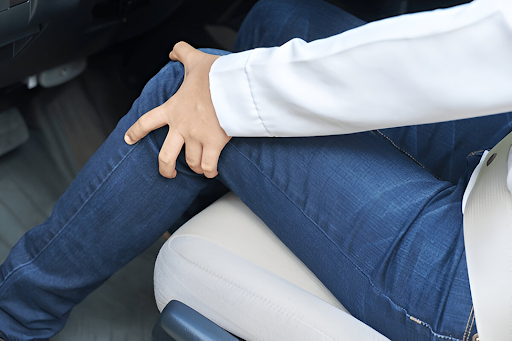Right leg stiffness after extended driving is a common issue for drivers, especially those who spend a lot of time on the road.
Why Does Right Leg Pain Happen After Driving?
Long drives require you to remain stillfor extended periods, which stress the right leg muscles tendons, and nerves, this result in the Right Lateral Pelvic Tilt. This pain is usually caused by the right leg’s repetitive motion when using the gas and brake pedals, which wear out and strain the muscles. Tension in the calf, hamstrings, and hip flexors can result from keeping the foot fixed on the pedal. Furthermore, bad posture or incorrect seat adjustment may make the problem worse by putting the leg in an uncomfortable position, which puts more strain on the knee, pelvis, and lower back.
Here are some pointers of why it does happen.
Prolonged Muscle Tension
While driving your right foot stays in continuous motion to operate on brake and accelerator. Your calve and hamstring muscles therefore take the majority of the movement they perform, which causes them to stiffen up, leading to issues like discomfort, and muscular fatigue.
Poor Posture
Staying in poor posture also makes the condition worse when you sit in the car with your seat badly adjusted. Sometimes, stretching or squeezing your leg too far or too close to reach the pedals creates tension in the leg. So sitting in bad posture causes the muscles to get tensed or numbed up as they remain in the same position for too long.
Sciatic Nerve Compression
Long hours of sitting can cause the sciatic nerve to be compressed. This nerve starts from the hips (lower back) and goes down to both legs. This compression causes sharp pain in the back and the right leg.
Repetitive Motion Injury
Continued use of the right leg for brake and accelerator can lead to overuse injuries in the ankle and foot. It also increases the connective IQ of the right leg while the left leg stays neutral which leads to an imbalance in the legs.
How Right Leg Pain Can Affect Your Overall Health
Long-term problems may arise if leg pain due to driving is ignored. Persistent strain on the muscles may develop into chronic discomforteven joint deterioration or pelvic rotation and tilting.
According to a specialist in musculoskeletal health, reliance on the dominant right leg while driving may enhance the “connective tissue IQ” on that side.Which can cause pelvic rotation and an irregular stride. This underscores the need to treat right leg pain early, as such imbalances can eventually result in spine-related pain conditions.
Practical Tips to Prevent and Relieve Right Leg Pain
While driving discomfort can be frustrating, there are several ways you can use to prevent and get rid of pain.
Adjust your Driving Position
Position your seat comfortably where you can easily reach the brake and accelerator without putting too much tension on your right leg. Maintain your back straight while driving, don’t indulge your back in a curved position.Also, you can use a cushion to sit on while driving.It can make the driver seat more comfortable for your hips.
Take Frequent Breaks
While driving for long hours you should take breaks in between to stretch your body. So you won’t feel any discomfort. If you are feeling any resistance in your back or leg, have a break as it will relax your muscles and you won’t get any back pain.
Incorporate Stretching and Strengthening Exercises
Stretching and strengthening exercises can help to improve muscle strength and endurance as well as ease pain.
· Hamstring and Calf Stretch
· Ankle Circle
· Hip Flexor Exercise
Keep a resistance band in the car to do stretching exercises while on long drives.
Maintain Good Posture While Driving
Maintain a straight posture while driving, keep your back straight shoulder wide and neck up. It is crucial to have a good sitting posture even when you are not driving.
Wear Comfortable Footwear
Choose shoes that are cushioned and flexible to promote natural foot mobility. Flip-flops and high heels don’t offer much support when driving.
Seek Medical Help
If you are not getting any results after doing all the home remedies, yoga, and stretching exercises, it is better to seek professional help. Conditions like sciatica, tendonitis, or joint disorders may need treatment from a physical therapist or chiropractor.
Conclusion
Long trips can lead to soreness in your right leg, which may signal that your body is under stress. By identifying causes and taking steps to adjust your posture, schedule rest breaks, and include stretching exercises in your lifestyle, you can significantly reduce discomfort and avoid future complications.
